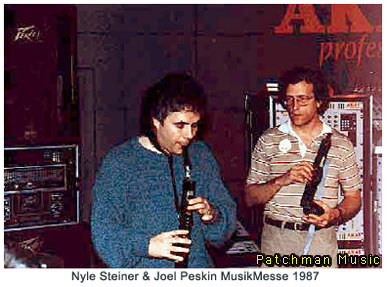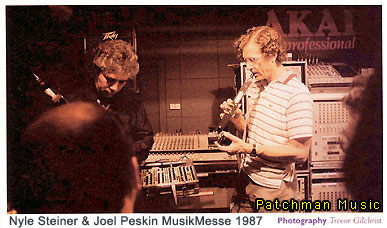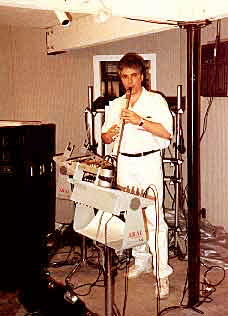


Joel Peskin
The EWI Story



Joel Peskin
The EWI Story

|
|
|
|
|
|
|
|
|
|

Buy your EWI5000, EWI USB, & EWI4000s from Patchman Music- The Wind Controller Specialists!! Click here to buy your EWI5000, EWI USB, & EWI4000s from Patchman Music We personally set up and calibrate EVERY EWI we sell. |
| Be sure to check out the amazing Aerophone Academy Podcast co-hosted by Patchman Music's own Matt Traum and Alistair Parnell (iSax Academy) for in depth discussions and interviews on everything related to wind controllers! |
The EWI Story
by Joel Peskin
EWI Pioneer Joel Peskin tells of his experiences in helping EWI / EVI inventor Nyle Steiner get connected with Akai
(The following is from Joel Peskin's webpage which no longer exists)
 The
EWI has played an integral part of my musical life and career
in Los Angeles, CA. It was one summer day in LA, 1981, when I
was working on a TV score at Evergreen recording studios. Next
door was a man demonstrating this newfangled contraption that
looked like an insect sprayer. I heard different sounds he played
and just shrugged it off as some oddball thing. Little did I
know that person was the inventor of the EWI and EVI- Nyle
Steiner- and how that instrument would change my musical
life forever. A couple of months later a close friend of mine
Judd Miller
was interested in going up to Nyle's house to see this EVI which
once was in production and made by Crumar in Italy.
The
EWI has played an integral part of my musical life and career
in Los Angeles, CA. It was one summer day in LA, 1981, when I
was working on a TV score at Evergreen recording studios. Next
door was a man demonstrating this newfangled contraption that
looked like an insect sprayer. I heard different sounds he played
and just shrugged it off as some oddball thing. Little did I
know that person was the inventor of the EWI and EVI- Nyle
Steiner- and how that instrument would change my musical
life forever. A couple of months later a close friend of mine
Judd Miller
was interested in going up to Nyle's house to see this EVI which
once was in production and made by Crumar in Italy.
I made the drive up to Nyle's house and watched another demonstration and was really impressed with all of the sound capabilities it had. At that time this instrument was analog and very limited in its sounds, but still very expressive and melodic. Judd ordered his EVI, but at that time I had to wait for a prototype EWI to be handmade by Nyle (how frustrating)!! Judd was already learning this new axe and I was waiting for him to build it (which was painfully slow). In the meantime I knew that keyboardist Ian Underwood had a prototype and I borrowed that for a while, and then used one that saxophonist Tom Scott had. When my unit was finished I was ready to jump right into the new Electronic Scene.
My good friend, composer Joseph Conlan, was scoring a new Paramount TV show and he was already heavy into electronic music ideas, hired Judd and myself to play our new EWI's. I remember us sharing a Roland space echo and every time I made a mistake changing octaves with my thumb rollers, it would make a blip sound and repeat over and over. That was the beginning of my career as a EWI player. Soon afterwards I had my own instrument and it was hooked up to an old Moog Prodigy, then I linked it up with a SMS synth module. I started to acquire a real fast technique and rapid tonguing and was always inspired by Judd Miller's cutting edge approach for new sounds and new synths. Now not only was I in demand as a sax player and doubler but I had this powerful new instrument at my fingertips too.
 By
1985 I was doing a lot of TV and Films and even records (Rick
Springfield "Hard To Hold"). My equipment list grew
larger as I always wanted more stuff. By now Nyle had made about
20 EWIs and was getting tired of all the people calling him for
new units. When Nyle converted the JL Cooper MIDI box and interfaced
this with the EWI it really exploded into another dimension.
MIDI was the new thing so we all could hook up to samplers, Oberheim
Xpanders, etc. I was able to play like a guitar, or mallets,
flutes and you name it. It was really fun and my career blossomed
in the LA studio scene.
By
1985 I was doing a lot of TV and Films and even records (Rick
Springfield "Hard To Hold"). My equipment list grew
larger as I always wanted more stuff. By now Nyle had made about
20 EWIs and was getting tired of all the people calling him for
new units. When Nyle converted the JL Cooper MIDI box and interfaced
this with the EWI it really exploded into another dimension.
MIDI was the new thing so we all could hook up to samplers, Oberheim
Xpanders, etc. I was able to play like a guitar, or mallets,
flutes and you name it. It was really fun and my career blossomed
in the LA studio scene.
Now that I was set up with all of this equipment and was in love with this instrument I wanted to start a business venture with inventor Nyle Steiner and longtime friend bassist Andy Muson and go into the manufacturing of the EWI and EVI. We had many meetings and met with inventor Bill Putnam (who holds patents of UREI, JBL eq. etc.) and wanted to mass produce these instruments. He warned us that it would be very costly and difficult to make and said we would be better off making a licensing deal with a major musical instrument company and just sit back an collect a royalty. It just so happened that Andy Muson had an old friend named Mike Matthews from NYC, an inventor who had a company called Electro Harmonix, and thought he would be helpful with our venture. It just so happened that Mike Matthews was already dealing with the AKAI Professional helping to develop their first digital sampler. Mike then arranged for me and Andy to fly to the Palmer House in Chicago in 1986 and demonstrate the EWI for AKAI Professional's president Jack Sugino and Koh Suzuki and Jerry Freed who was the president of IMC musical instruments.
 I played a great demo for them and they were very impressed
and interested in making a licensing deal with us, "THE
EWI GROUP". After we negotiated a deal it was up to Nyle
to send AKAI two prototypes of the EWI and EVI with MIDI and
all of the inventor's bells and whistles added on. At that point,
AKAI's R&D department refined the package and got it ready for
mass production. This was very exciting for me, indeed. Soon
they had a model ready for production. It was very buggy at first
but soon it was all worked out. This first model was the Akai EWI1000
and EVI1000, along with the EWV2000 sound module and it looked great.
In 1987, Nyle and myself flew over to the Frankfurt Musikmesse
show and demonstrated the instruments but had to play on the
original prototypes because the new models were not working yet!!
It was a big hit.
I played a great demo for them and they were very impressed
and interested in making a licensing deal with us, "THE
EWI GROUP". After we negotiated a deal it was up to Nyle
to send AKAI two prototypes of the EWI and EVI with MIDI and
all of the inventor's bells and whistles added on. At that point,
AKAI's R&D department refined the package and got it ready for
mass production. This was very exciting for me, indeed. Soon
they had a model ready for production. It was very buggy at first
but soon it was all worked out. This first model was the Akai EWI1000
and EVI1000, along with the EWV2000 sound module and it looked great.
In 1987, Nyle and myself flew over to the Frankfurt Musikmesse
show and demonstrated the instruments but had to play on the
original prototypes because the new models were not working yet!!
It was a big hit.
Soon afterwards I wrote and co-produced a music performance video for AKAI entitled SWEET FOR C.P. in which it showcased an EVI performance by Nyle Steiner (playing a cello and oboe improv), an EWI performance by Michael Brecker, (Xpander chordal improvs and power electric guitar), and myself (Harmon Mute and Brass & Sax section improv). These were all set to a funky beat and filmed in NYC for AKAI ELECTRIC CO JAPAN. Soon after I did a demonstration video with Nyle Steiner for the purpose of teaching the basic techniques of the instrument. Now we were all cooking and the instrument was gaining a foothold in the world market and every sax player and wind player was interested in buying one. I always thought this was a lot better than the Yamaha WX7. It was more fluid and easier to facilitate.
By 1988, this new instrument was selling in the thousands and I was working even more in the recording studios. Now with MIDI we were playing sound modules like the Oberheim Xpander, Prophet 2002, Akai S1000, Roland samplers, and anything else we could get our hands on. The EWI was great at copying the nuances of any instrument like a cello, trumpet, brass, sax, pan pipes, and harmonica and these were all used by producers and composers. I used the EWI on a series of 17 nature CDs which I produced for Metacom Inc. where all of the aftertouch information was recorded on to the Performer sequencing program and played directly into the computer. Then the sounds were replayed by the computer back to the Roland SP700 sample player. This was how I was able to access a great library of sounds including my own samples made on the S1000 and then converted to the Roland format. This enabled me to keep all of the music in the digital domain. One album I did for Metacom was a Xmas CD, entitled Top Brass, where I played all Brass patches featured as a lead on pop style rhythm tracks. I sounded like a Trombone, Harmon Mute, Bones and Saxes, Latin Brass Section, and legit Brass Choir, it's still amazes me how real this all sounds. A lot of the trick is to capture the style and nuances of the real players. It's like being a musical MIME...
[At the time of this writing] Akai has been working on their third EWI model and has sold at least 15,000 units worldwide. I always enjoy seeing all the great sax players around the world playing their EWI's and chuckle :) knowing I played a crucial part in getting them sold around the world.
- Joel Peskin
For more information on Nyle Steiner and the history of the EWI and EVI, be sure to visit the Nyle Steiner Homepage.
The Wind Controller FAQ | Wind Controller Soundbanks
| Be sure to check out the amazing Aerophone Academy Podcast co-hosted by Patchman Music's own Matt Traum and Alistair Parnell (iSax Academy) for in depth discussions and interviews on everything related to wind controllers! |


Check out the INCREDIBLE PATCHMAN TURBO VL Upgrade Chip for the Yamaha VL70-m |

This page was last updated Wednesday, August 6, 2025
Copyright ©1996-2025 PATCHMAN MUSIC, LLC, All Rights Reserved
Purchase Terms and Conditions
All trademarks are property of their respective holders


